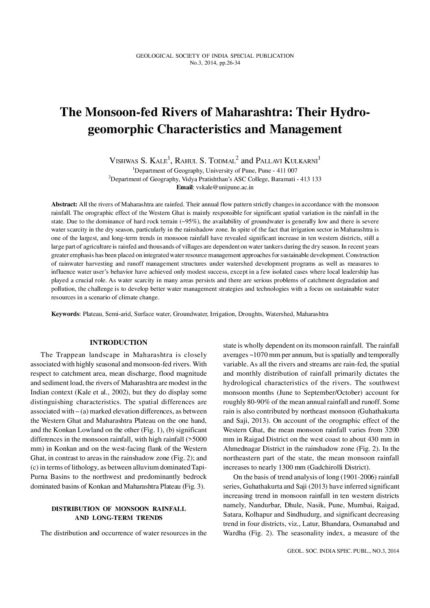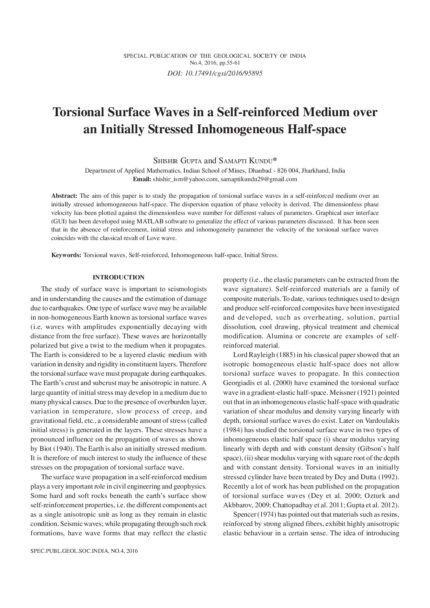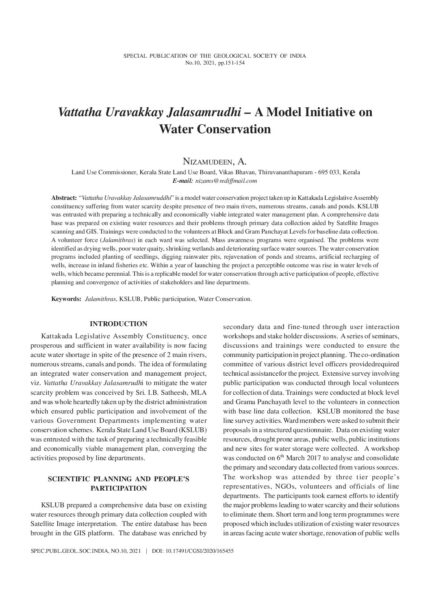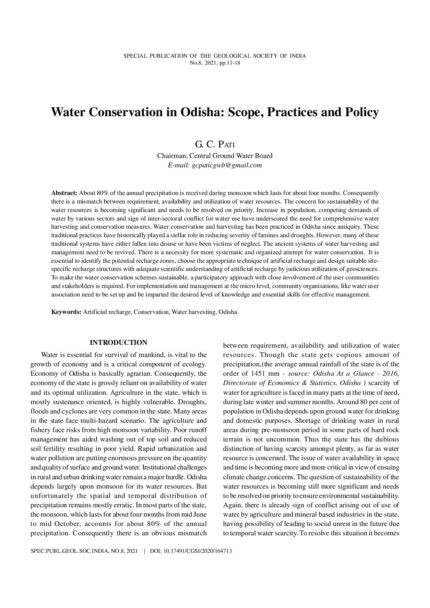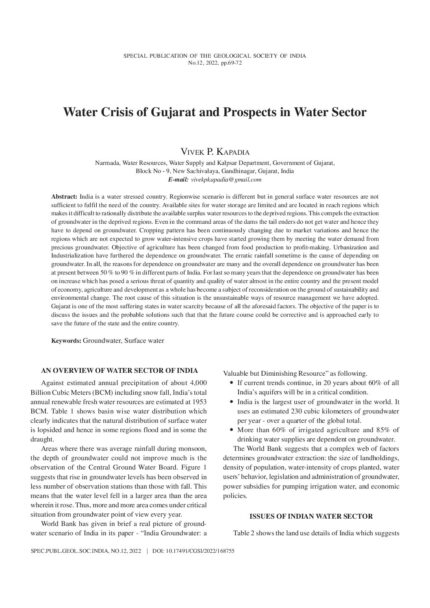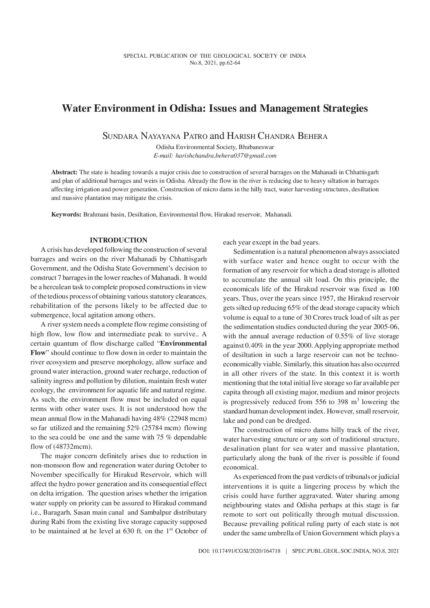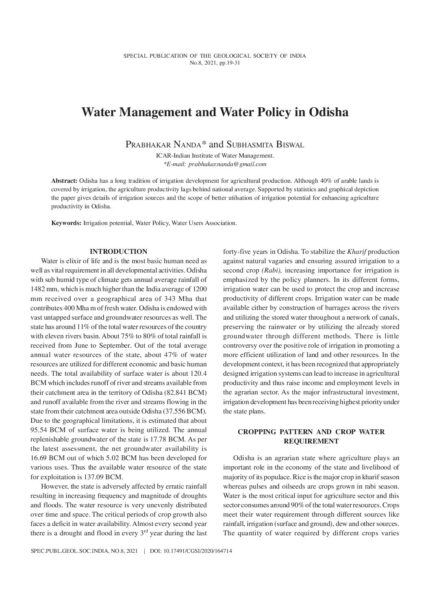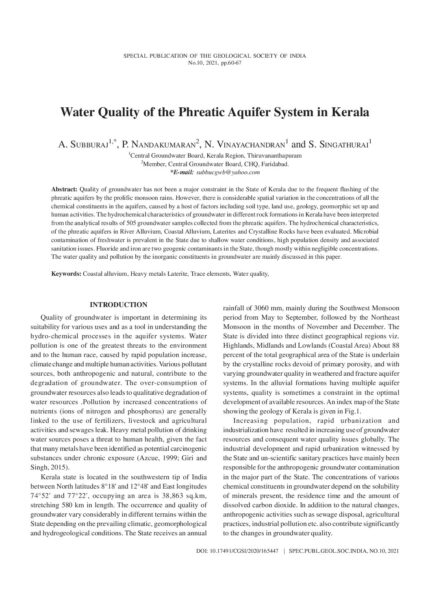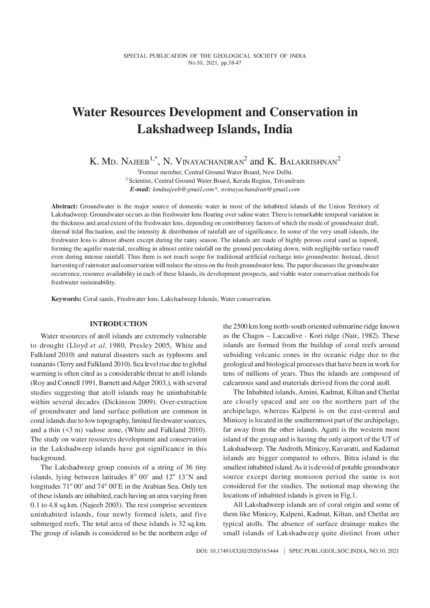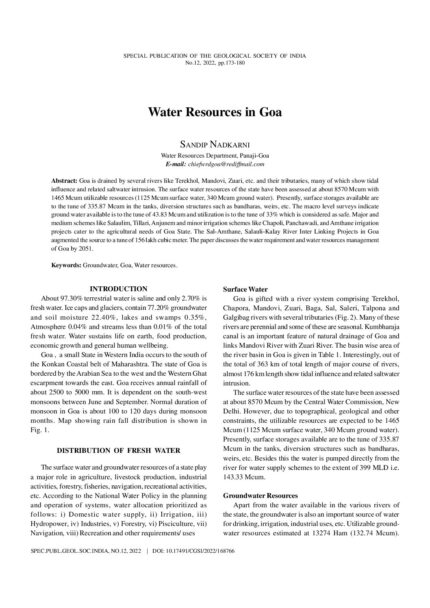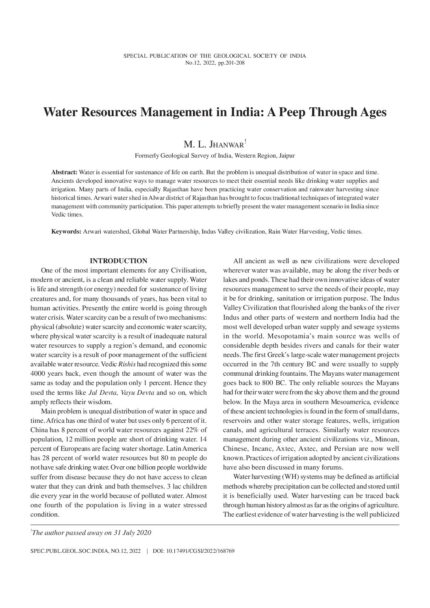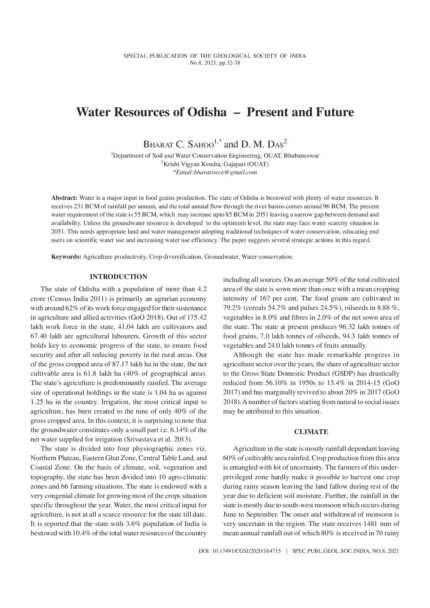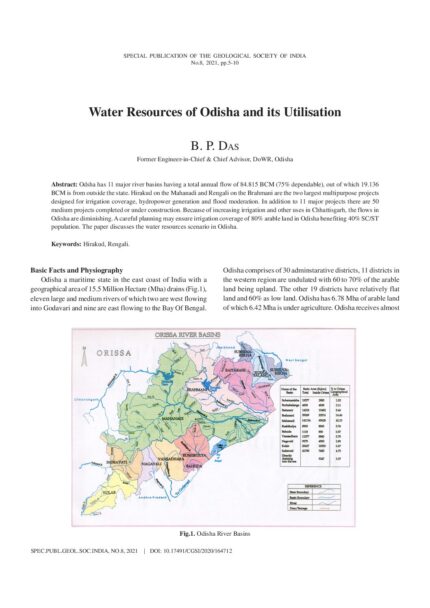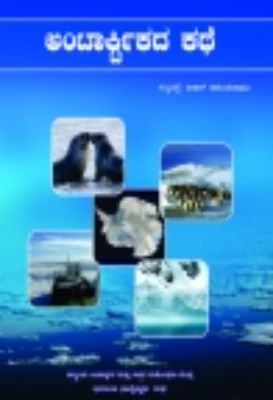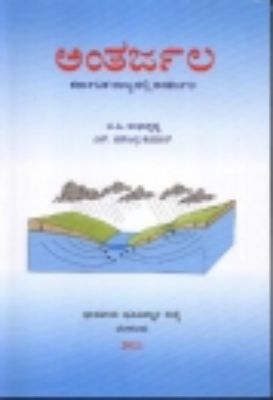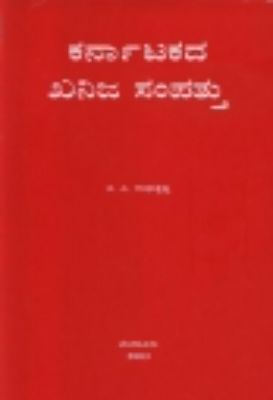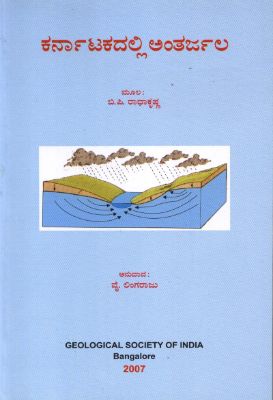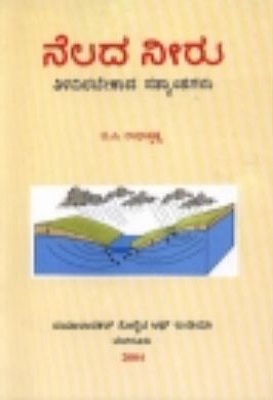Publications
The Monsoon-Fed Rivers of Maharashtra: Their Hydrogeomorphic Characteristics and Management
SKU:
C-62868
All the rivers of Maharashtra are rainfed. Their annual flow pattern strictly changes in accordance with the monsoon rainfall. The orographic effect of the Western Ghat is mainly responsible for significant spatial variation in the rainfall in the state. Due to the dominance of hard rock terrain (?95%), the availability of groundwater is generally low and there is severe water scarcity in the dry season, particularly in the rainshadow zone. In spite of the fact that irrigation sector in Maharashtra is one of the largest, and long-term trends in monsoon rainfall have revealed significant increase in ten western districts, still a large part of agriculture is rainfed and thousands of villages are dependent on water tankers during the dry season. In recent years greater emphasis has been placed on integrated water resource management approaches for sustainable development. Construction of rainwater harvesting and runoff management structures under watershed development programs as well as measures to influence water user's behavior have achieved only modest success, except in a few isolated cases where local leadership has played a crucial role. As water scarcity in many areas persists and there are serious problems of catchment degradation and pollution, the challenge is to develop better water management strategies and technologies with a focus on sustainable water resources in a scenario of climate change.
The Water Management in West Bengal: Exploring the Prospects for Sustainability
SKU:
C-165837
Water as a natural resource is so vital for the survival of the living beings including mankind that it is referred as ?elixir of life? in the ancient holy books. Although water is a major planetary component so far as its abundance is considered, but the percentage of total water resource available for human use is very limited. The increasing demand of water, for meeting the need of exponentially growing human population, is interfering the natural cycle in such a way that there is already serious constraint on the potential of replenishment of the usable water resource especially the ground water reserves. Several parts of the world are already facing serious crisis of water. West Bengal, where there was no real threat of water scarcity because of significant rain fall, is also likely to face serious shortage of water in no distant period. Other than increasing population and urbanization, the agricultural practice followed after the ?green revolution? through numerous minor-irrigation projects has put a serious threat on the ground water availability. Unless a sustainable water policy is formulated, the State may become a water scarce in a foreseeable future. West Bengal, being a part of the largest delta of the World, is endowed with extensive wetlands which render many ecological services to the Society and Ecosystem. Unfortunately these wetlands are fast disappearing under mounting pressures of urbanization and other uses. The conservation of wetland demands top priority.
Vattatha Uravakkay Jalasamrudhi ? A Model Initiative on Water Conservation
SKU:
C-165455
?Vattatha Uravakkay Jalasamruddhi? is a model water conservation project taken up in Kattakada Legislative Assembly constituency suffering from water scarcity despite presence of two main rivers, numerous streams, canals and ponds. KSLUB was entrusted with preparing a technically and economically viable integrated water management plan. A comprehensive data base was prepared on existing water resources and their problems through primary data collection aided by Satellite Images scanning and GIS. Trainings were conducted to the volunteers at Block and Gram Panchayat Levels for baseline data collection. A volunteer force (Jalamithras) in each ward was selected. Mass awareness programs were organised. The problems were identified as drying wells, poor water quaity, shrinking wetlands and deteriorating surface water sources. The water conservation programs included planting of seedlings, digging rainwater pits, rejuvenation of ponds and streams, artificial recharging of wells, increase in inland fisheries etc. Within a year of launching the project a perceptible outcome was rise in water levels of wells, which became perennial. This is a replicable model for water conservation through active participation of people, effective planning and convergence of activities of stakeholders and line departments.
Water Conservation in Odisha: Scope, Practices and Policy
SKU:
C-164713
About 80% of the annual precipitation is received during monsoon which lasts for about four months. Consequently there is a mismatch between requirement, availability and utilization of water resources. The concern for sustainability of the water resources is becoming significant and needs to be resolved on priority. Increase in population, competing demands of water by various sectors and sign of inter-sectoral conflict for water use have underscored the need for comprehensive water harvesting and conservation measures. Water conservation and harvesting has been practiced in Odisha since antiquity. These traditional practices have historically played a stellar role in reducing severity of famines and droughts. However, many of these traditional systems have either fallen into disuse or have been victims of neglect. The ancient systems of water harvesting and management need to be revived. There is a necessity for more systematic and organized attempt for water conservation. It is essential to identify the potential recharge zones, choose the appropriate technique of artificial recharge and design suitable sitespecific recharge structures with adequate scientific understanding of artificial recharge by judicious utilization of geosciences. To make the water conservation schemes sustainable, a participatory approach with close involvement of the user communities and stakeholders is required. For implementation and management at the micro level, community organisations, like water user association need to be set up and be imparted the desired level of knowledge and essential skills for effective management.
Water Crisis of Gujarat and Prospects in Water Sector
Conference Papers, SP-12: Water Resources of Western and Central Regions of India: Status, Issues and Strategies
SKU:
C-168755
India is a water stressed country. Regionwise scenario is different but in general surface water resources are not sufficient to fulfil the need of the country. Available sites for water storage are limited and are located in reach regions which makes it difficult to rationally distribute the available surplus water resources to the deprived regions. This compels the extraction of groundwater in the deprived regions. Even in the command areas of the dams the tail enders do not get water and hence they have to depend on groundwater. Cropping pattern has been continuously changing due to market variations and hence the regions which are not expected to grow water-intensive crops have started growing them by meeting the water demand from precious groundwater. Objective of agriculture has been changed from food production to profit-making. Urbanization and Industrialization have furthered the dependence on groundwater. The erratic rainfall sometime is the cause of depending on groundwater. In all, the reasons for dependence on groundwater are many and the overall dependence on groundwater has been at present between 50 % to 90 % in different parts of India. For last so many years that the dependence on groundwater has been on increase which has posed a serious threat of quantity and quality of water almost in the entire country and the present model of economy, agriculture and development as a whole has become a subject of reconsideration on the ground of sustainability and environmental change. The root cause of this situation is the unsustainable ways of resource management we have adopted. Gujarat is one of the most suffering states in water scarcity because of all the aforesaid factors. The objective of the paper is to discuss the issues and the probable solutions such that that the future course could be corrective and is approached early to save the future of the state and the entire country.
Water Environment in Odisha: Issues and Management Strategies
SKU:
C-164718
The state is heading towards a major crisis due to construction of several barrages on the Mahanadi in Chhattisgarh and plan of additional barrages and weirs in Odisha. Already the flow in the river is reducing due to heavy siltation in barrages affecting irrigation and power generation. Construction of micro dams in the hilly tract, water harvesting structures, desiltation and massive plantation may mitigate the crisis.
Water Management and Water Policy in Odisha
SKU:
C-164714
Odisha has a long tradition of irrigation development for agricultural production. Although 40% of arable lands is covered by irrigation, the agriculture productivity lags behind national average. Supported by statistics and graphical depiction the paper gives details of irrigation sources and the scope of better utilsation of irrigation potential for enhancing agriculture productivity in Odisha.
Water Management in India: Issues and Strategies
SKU:
C-95965
Water is crucial for a country's development and economic growth. Though India is endowed with bounty of rainfall, unplanned development and management of water is leading to water scarcity, economic and environmental strain which may increase manifold in the coming decades. Studies indicate that integrated management of all water resources can avert the impending water crisis. The paper briefly narrates and analyses the water management issues, and future strategies.
Water Management in Urban Scenario with Special Reference to Karnataka
SKU:
C-95949
Water is one of the basic necessities for human sustenance.The per capita availability of fresh water is decreasing day by day due to increase in population , industrialization and consequent pollution.Water being a renewable resource, there is ample scope to use technologies to treat polluted water, manage it effectively using sound management principles. This paper examines various issues viz.,Legal,Technical, Financial, Institutional, Ethical and Community participation with special reference to Karnataka state and possible solutions to manage this precious resource effectively.
Water Quality of the Phreatic Aquifer System in Kerala
SKU:
C-165447
Quality of groundwater has not been a major constraint in the State of Kerala due to the frequent flushing of the phreatic aquifers by the prolific monsoon rains. However, there is considerable spatial variation in the concentrations of all the chemical constituents in the aquifers, caused by a host of factors including soil type, land use, geology, geomorphic set up and human activities. The hydrochemical characteristics of groundwater in different rock formations in Kerala have been interpreted from the analytical results of 505 groundwater samples collected from the phreatic aquifers. The hydrochemical characteristics, of the phreatic aquifers in River Alluvium, Coastal Alluvium, Laterites and Crystalline Rocks have been evaluated. Microbial contamination of freshwater is prevalent in the State due to shallow water conditions, high population density and associated sanitation issues. Fluoride and iron are two geogenic contaminants in the State, though mostly within negligible concentrations. The water quality and pollution by the inorganic constituents in groundwater are mainly discussed in this paper.
Water Resources Development and Conservation in Lakshadweep Islands, India
SKU:
C-165444
Groundwater is the major source of domestic water in most of the inhabited islands of the Union Territory of Lakshadweep. Groundwater occurs as thin freshwater lens floating over saline water. There is remarkable temporal variation in the thickness and areal extent of the freshwater lens, depending on contributory factors of which the mode of groundwater draft, diurnal tidal fluctuation, and the intensity & distribution of rainfall are of significance. In some of the very small islands, the freshwater lens is almost absent except during the rainy season. The islands are made of highly porous coral sand as topsoil, forming the aquifer material, resulting in almost entire rainfall on the ground percolating down, with negligible surface runoff even during intense rainfall. Thus there is not much scope for traditional artificial recharge into groundwater. Instead, direct harvesting of rainwater and conservation will reduce the stress on the fresh groundwater lens. The paper discusses the groundwater occurrence, resource availability in each of these Islands, its development prospects, and viable water conservation methods for freshwater sustainability.
Water Resources in Goa
Conference Papers, SP-12: Water Resources of Western and Central Regions of India: Status, Issues and Strategies
SKU:
C-168766
Goa is drained by several rivers like Terekhol, Mandovi, Zuari, etc. and their tributaries, many of which show tidal influence and related saltwater intrusion. The surface water resources of the state have been assessed at about 8570 Mcum with 1465 Mcum utilizable resources (1125 Mcum surface water, 340 Mcum ground water). Presently, surface storages available are to the tune of 335.87 Mcum in the tanks, diversion structures such as bandharas, weirs, etc. The macro level surveys indicate ground water available is to the tune of 43.83 Mcum and utilization is to the tune of 33% which is considered as safe. Major and medium schemes like Salaulim, Tillari, Anjunem and minor irrigation schemes like Chapoli, Panchawadi, and Amthane irrigation projects cater to the agricultural needs of Goa State. The Sal-Amthane, Salauli-Kalay River Inter Linking Projects in Goa augmented the source to a tune of 156 lakh cubic meter. The paper discusses the water requirement and water resources management of Goa by 2051.
Water Resources Management in India: A Peep Through Ages
Conference Papers, SP-12: Water Resources of Western and Central Regions of India: Status, Issues and Strategies
SKU:
C-168769
Water is essential for sustenance of life on earth. But the problem is unequal distribution of water in space and time. Ancients developed innovative ways to manage water resources to meet their essential needs like drinking water supplies and irrigation. Many parts of India, especially Rajasthan have been practicing water conservation and rainwater harvesting since historical times. Arwari water shed in Alwar district of Rajasthan has brought to focus traditional techniques of integrated water management with community participation. This paper attempts to briefly present the water management scenario in India since Vedic times.
Water Resources of Odisha ? Present and Future
SKU:
C-164715
Water is a major input in food grains production. The state of Odisha is bestowed with plenty of water resources. It receives 231 BCM of rainfall per annum, and the total annual flow through the river basins comes around 96 BCM. The present water requirement of the state is 55 BCM, which may increase upto 85 BCM in 2051 leaving a narrow gap between demand and availability. Unless the groundwater resource is developed to the optimum level, the state may face water scarcity situation in 2051. This needs appropriate land and water management adopting traditional techniques of water conservation, educating end users on scientific water use and increasing water use efficiency. The paper suggests several strategic actions in this regard.
Water Resources of Odisha and its Utilisation
SKU:
C-164712
Odisha has 11 major river basins having a total annual flow of 84.815 BCM (75% dependable), out of which 19.136 BCM is from outside the state. Hirakud on the Mahanadi and Rengali on the Brahmani are the two largest multipurpose projects designed for irrigation coverage, hydropower generation and flood moderation. In addition to 11 major projects there are 50 medium projects completed or under construction. Because of increasing irrigation and other uses in Chhattisgarh, the flows in Odisha are diminishing. A careful planning may ensure irrigation coverage of 80% arable land in Odisha benefiting 40% SC/ST population. The paper discusses the water resources scenario in Odisha.
Water Security in Jharkhand
SKU:
C-165861
Water is a ?Common Property Resource? that is fast reaching in the regime of tradable commodity. In changing circumstances, the term ?Water Security? assumes importance. The author is working with Water and Environment related issues for last one decade. In upcoming series, he provides a commentary on status of Socio- Technical issues related to Water Security in Jharkhand. Rapid urbanization and population growth have affected the net availability of water in the state since its creation in 2000. Tapping optimal volume of rainwater has been a longstanding challenge in undulating central Indian craton. Recent efforts by various agencies to produce more food under more hostile condition and Improving efficiency & productivity of water only lead to unsafe exploitation and existing concerns. The paper reviews select issues related to Ground Water availability, quality and sustainability in the state and recommend a rout map for achieving Sustainable Development Goal related to availability of safe water for all, in context for the state. A professionally Managed institution of Hydrogeology experts in the state with dedicated behavioral change initiatives is considered as key to save the state from a well-foreseen disaster.

